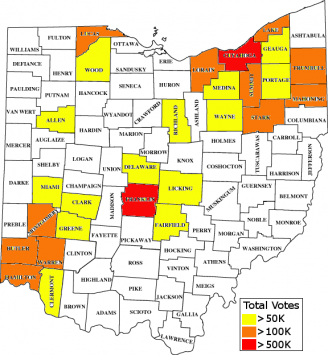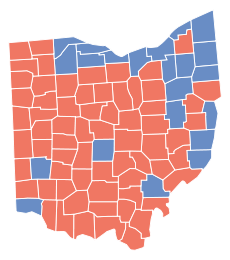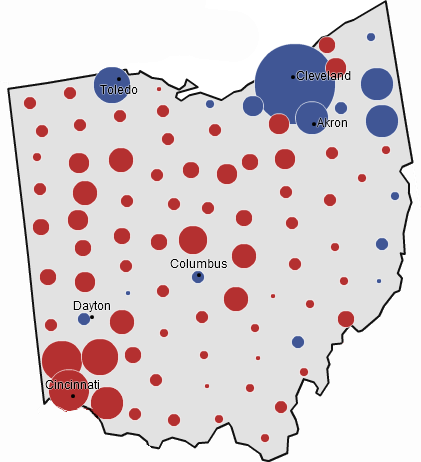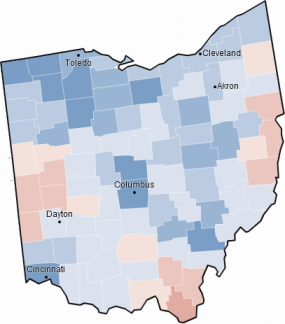Cross posted at Daily Kos
The other day, I shattered the ugly belief that the Republican candidate in the 23rd congressional district, Dede Scozzafava, was the most liberal. That post was a direct response to Markos’ post Thursday, which also included a critique of Democratic candidate Bill Owens.
One of the arguments made by Markos is that Owens is a “conservaDem” and that he would be just another member of the Blue Dog Coalition should he win in November. Owens, who was an independent but has changed his party affiliation to become a Democrat, was picked over two Democrats to run.
Because of that, there is a high level of uncertainty about Owens. Progressives are skeptical (and rightfully so) because they see the Blue Dogs throughout the country and don’t want to see Owens end up just another Blue Dog. I also think that some of this skepticism is related to the district Owens is running in. He isn’t the first Democrat running in an upstate New York district whose views have been questioned and who has been considered a prospective Blue Dog. It apparently comes with the territory, whether it’s fair or not.
Here are two of Owens’ television ads which give you an idea of his approach. His emphasis is jobs and creating jobs in the North Country.
This is what we know about Owens based on the issues page available on his campaign website:
– His area of expertise is jobs. He has a seven-point plan for creating jobs. The plan includes: An emphasis on green energy, recruiting Canadian investment (if you’re familiar with NY-23, you know that it borders Canada), keeping Fort Drum strong, job training for veterans and graduates, investing in local infrastructure, higher education and agriculture.
– When it comes to health care reform, he supports all of the following: Controlling health care costs for the middle class; providing affordable health insurance to every American; preventing health insurance companies from using preexisting conditions and caps on lifetime coverage; giving small businesses and individuals access to lowest rates available to large corporations and government employees; allowing anybody to keep their existing coverage.
This part of his health care reform platform is very interesting:
Using profits from repayment of TARP funds, allowing the Bush tax cuts for the wealthy to expire, increased efficiency in our health care system (like putting all health care records on-line and requiring insurance companies to accept payment on-line), and cutting special interest tax loopholes (like tax benefits for companies that offshore jobs) to help pay for health care reform.
He also proposes the following: Allowing states to use savings from elimination of uncompensated care costs (Over $100 billion annually) to reduce taxes. In New York this would help prevent property tax increases.
Owens opposes Medicare benefit cuts, taxing health care benefits and increasing taxes on the middle class.
In addition to all of that, we also know the following:
– Owens supports the Employee Free Choice Act in its current form.
On top of asking about EFCA, the Watertown Daily Times also asked the candidates where they stand on a handful of other issues. Here’s where Owens stands on those issues:
– American Recovery and Reinvestment Act: Owens said he would have voted for the ARRA if he was in the House at the time. Scozzafava also said she would have supported it, but then gave critiques of the stimulus that showed she has some problems with the package, which tells me that maybe she would not have voted for it. (Let me just add that it is easy to say now you would vote for it, as a Democrat or Republican, given the ARRA’s positive impact.)
This is what Owens said about the stimulus:
Mr. Owens said he’d like to see more of the funds redirected toward job creation or assisting farmers.
“What you want to do with the stimulus dollars is set up a infrastructure base so that people going forward can independently make their decisions and hopefully be successful in their businesses,” he said.
– Taxation of health benefits: Owens said in the article that he would have to look at it before giving a clear position. That article was written at the end of August. His website, which was recently updated, tells us that he is opposed to taxing health benefits.
– Cash for Clunkers: Owens said he supports the CARS program (commonly known as Cash for Clunkers) and that he believes “It helped put labor back to work. And it did a lot of important things to get the economy moving in the right direction.”
– Lilly Ledbetter Fair Pay Act: Owens said he wasn’t familiar with this legislation (hard to imagine, given its profile) but he did say that “Everyone should be paid fair wages for their work, irrespective of any other factor that may come into play.” While Owens should know the legislation, that position is better than the position of his two conservative opponents. Scozzafava (a woman, I remind you) said she was oppose the legislation. Conservative Doug Hoffman also said he would oppose the bill.
– Davis-Bacon: If you aren’t familiar with this (the Watertown Daily-Times apparently thought this was a good question to ask), Davis-Bacon is described as the following:
“The law, which has been in effect since the Great Depression, requires construction workers to be paid prevailing wages on public works projects.”
Owens said he would support Davis-Bacon staying in place.
Some of the other positions I have been able to find on Owens is that he supports taking tax breaks away from companies who send jobs out of New York to other locations.
Bill Owens thinks that companies receiving tax breaks from the government must live up to their end of the promise. That’s why he supports holding big businesses accountable by taking away tax breaks from companies that outsource jobs away from Upstate New York.
He also supports agriculture and rural development and this statement on his website gives us a glimpse into what his approach will be when it comes to agriculture:
That’s why Owens will fight to help local farmers and ranchers by using subsidies and import limits to make sure they get fair prices for their goods. And Owens supports Senator Chuck Schumer’s call for an investigation into why dairy farmers are getting paid lower and lower prices for their milk, while the price of milk remains high in stores. Bill will go to Congress and work for farm policy that works for producers as well as consumers to make our local economy work better for everyone.
New York has been hit hard by the dairy price crisis. One of the factors that plays into that are imports that are brought in from outside of New York (and in certain cases, outside of the country) and compete with local producers. Dairy farmers aren’t getting enough to cover the cost of producing milk and that has caused many problems for these farmers. It is key for Owens to address this issue. As an upstate representative, he will be talking about it a lot.
Social issues: There is very limited information out there, but this is what we know about Owens and two big issues: Choice and marriage equality.
On marriage equality, Owens said this to PolitickerNY:
On the wedge issue of same-sex marriage, Owens is to the right of his Republican opponent Scozzafava. He does not support full marriage–he opposes any federal action on the “states rights issue”–telling me, “I fully support equal rights for everybody, and certainly civil unions are in that mix. For religious reasons, I have difficulty with the use of the word marriage in that process.”
That same PolitickerNY piece said that “Both Scozzafava and Owens are pro-choice; Conservative Doug Hoffman is against same-sex marriage and is pro-life.”
To what degree Owens is pro-choice (there are other reproductive rights issues, obviously, that he should be asked about) remains to be seen.
Here’s the moment of truth: What ideology does Owens belong to? I have a hard time calling him a “conservaDem” or prospective Blue Dog. But I also have a hard time calling “progressive” or “liberal.” This is a man who has been an independent. And in the media accounts about this race, the word “moderate” has been tossed around. I tend to agree with the perception here: Owens is a moderate. We do need to know more (while I know this post is helpful, we need more information on him) but this is a start. The only thing people seem to know about Owens is that he isn’t a Democrat. That leads to immediate skepticism about what he will do, if elected.
Owens has made one thing clear: He will support the President. He’s the only candidate saying that and that’s something we need to focus on.
I hopefully outlined all the reasons why you shouldn’t support Dede Scozzafava. I should also add that she is opposed to cap and trade legislation (even though her predecessor, John McHugh, supported the climate change bill) and that she supports the Bush tax cuts. Owens does not support the Bush tax cuts and has put an emphasis on keeping taxes low for the middle class.
To close, I don’t believe Owens will be a Blue Dog should he be elected. But I also know that we need to know more about Owens. There has been a lack of access and information. Everything I have put here (with the exception of a few points) are items I had to look up on my own. There has been no clarification from the campaign on certain positions and that is something we need. We are working on getting that information, but for now, I hope this will suffice.





